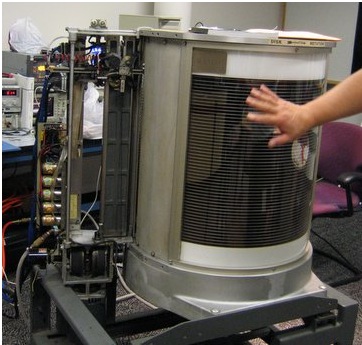More on First HDD IBM RAMAC
Usable capacity of 3.75MB and priced at $34,500
This is a Press Release edited by StorageNewsletter.com on September 10, 2014 at 2:58 pmThis is an email send by Tom Gardner,president of System Surety Group, who was a volunteer for Computer History Museum, and formely VP at SyQuest, Shugart and Memorex.
Your article History: First HDD at 55 From IBM at 100, is being cited as Wikipedia a a reliable source for the RAMAC capacity of 4.4MB and a 1956 purchase price of $50,000.
I believe the actual statistics are 5 million 6-bit characters = 3.75MB and $34,500, the latter comes from the 1961 Ballistic Research Laboratories Third Survey Of Domestic Electronic Digital Computing Systems and since it is contemporaneous to the actual RAMAC should be reliable. I would appreciate a correction since your article is now being cited as an authoritative source in Wikipedia.
RAMAC mechanism at Computer History Museum
I am sure of the capacity and reasonably certain of the price, as follows:
Capacity
In modern terms the RAMAC 350 used a 6/8(1,7) run length limited code (RLL), encoding 6 data bits (not seven) into 8 channel bits with a minimum spacing of 1 and a maximum spacing of 7. This is disclosed in RAMAC 305 Customer Engineering Theory Of Operations, IBM Corp, 1959, as follows:
“Within RAMAC, all data is read, transferred, and written serially by word. character, and bit. There are eight bit positions within each character position. They are identified as bits S, X, 0, 1, 2, 4, 8, and R. Bit S merely provides a space between the recording bit positions of each character, and is not used in the bit coding. Bit R has no numeric or alphabetic value, but is added to certain characters so that every character will have an odd number of bits. This convention makes possible a technique whereby RAMAC may perform a validity check on each character transferred.”
RLL codes are used throughout storage and in all cases the capacity is based upon data bits not channel bits such as parity and space. A simple example is the CD which encodes eight data bits to fourteen channel bits (EFM) and then adds a bunch of parity bits but the capacity is stated in terms of data bits not channel bits.
Thus the six data bits X, 0, 1, 2, 4 and 8 yield a capacity of 5 x 6/8 = 3.75MB
Purchase Price
While IBM did in 2006 say the price was $50,000 it is not clear where this came from and frankly there is little information out there.
However, the March 1961 Ballistic Research Laboratories (BRL) A Third Survey of Domestic Electronic Digital Computing Systems, section on IBM 305 RAMAC (p. 314-331) is mainly about the double density 350s but does $34,500 purchase price at Boeing Wichita. The BRL report also reports several instances of Model 1 pricing at $650/month rental which is confirmed in Emerson Pugh’s book “Building IBM where the rental price of the 350 Model 1 is stated as $650/month (out of a 305 rental price of $3,200/month). This suggests the BRL report is accurate.
A test of an IBM purchase price is the ratio of rental to purchase price. For this we can turn to Phister, “Data Processing Technology and Economics, Second Edition,” 1979 where in Table II.2.12.1 Moving Head Files, he tabulates the price to rental ratio of nine early IBM disk drives. The most comparable drive is the double density 350, the 350 Model 3 which has a ratio of 53:1, implying a purchase price of $34,350, a price remarkably close to the one reported by BRL. More interesting is that the maximum ratio is 55:1 suggesting a maximum original 350 purchase price of $35,750, well below the $50,000 price cited by IBM in 2006.
Read also:
IBM 305 RAMAC Data Processing System
Random Access Method of Accounting and Control














 Subscribe to our free daily newsletter
Subscribe to our free daily newsletter


